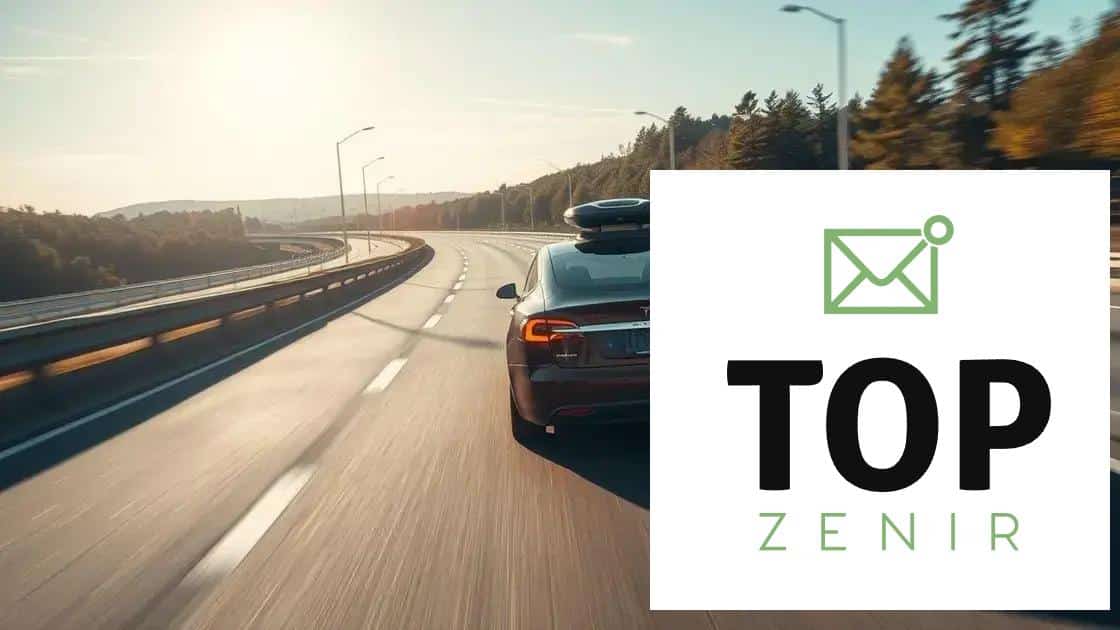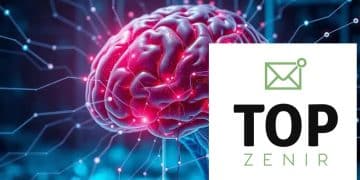Tesla’s Full Self-Driving logs 22B miles: What it means

Tesla’s Full Self-Driving technology utilizes extensive real-world data to enhance autonomous driving capabilities, focusing on safety features and continuous improvements to provide a more reliable driving experience.
Tesla’s Full Self-Driving logs 22B miles of data, sparking discussions on the implications for the future of driving. Have you ever wondered how this technology could change your daily commute?
Understanding Tesla’s Full Self-Driving technology
Understanding Tesla’s Full Self-Driving technology is crucial to grasping the future of autonomous vehicles. This technology aims to provide a safe and efficient driving experience without human intervention. By utilizing advanced sensors, cameras, and artificial intelligence, Tesla vehicles can navigate complex environments.
Key Components of Full Self-Driving
Tesla’s Full Self-Driving (FSD) system incorporates several components that work together seamlessly. Some of these include:
- Hardware: Tesla cars are equipped with specialized cameras and sensors that detect obstacles and traffic signs.
- Software: The FSD software processes the data collected by hardware to make real-time driving decisions.
- Neural Networks: Tesla trains neural networks using vast amounts of driving data to improve the AI’s ability to predict and react to various situations.
One impressive aspect of FSD is its ability to learn from real-world experiences. The system collects data from every drive, continuously enhancing its understanding of road conditions, traffic patterns, and driver behaviors.
Benefits of Full Self-Driving Technology
This technology is not just about convenience; it also aims to improve road safety. According to studies, autonomous driving could significantly reduce accidents caused by human error. In addition, FSD enhances traffic flow, helping to alleviate congestion.
Tesla’s commitment to constant improvement means the FSD features keep evolving. Users regularly receive updates that enhance functionalities and introduce new capabilities. By embracing this innovative approach, Tesla sets a benchmark for the automotive industry.
In summary, Tesla’s Full Self-Driving technology represents a significant leap forward in driving innovation. Understanding its components and benefits helps appreciate the role of autonomous vehicles in shaping the future of transportation.
Safety features of Tesla’s Full Self-Driving
The Safety features of Tesla’s Full Self-Driving system play a crucial role in enhancing road safety. Tesla has integrated multiple layers of technology designed to reduce accidents and protect drivers, passengers, and pedestrians alike. By utilizing sophisticated sensors and AI, the system constantly scans the environment and makes informed decisions in real-time.
Key Safety Innovations
Several innovations contribute to the overall safety of the Full Self-Driving technology. These include:
- Automatic Emergency Braking: This feature detects potential collisions and applies the brakes automatically to prevent or mitigate impacts.
- Lane Keeping Assistance: The system helps maintain the vehicle’s position in its lane, preventing unintentional lane departures.
- Adaptive Cruise Control: This feature automatically adjusts the vehicle’s speed to maintain a safe following distance from other vehicles.
Tesla’s system offers real-time data processing, allowing it to respond instantly to sudden changes on the road. For instance, if a pedestrian steps onto the road unexpectedly, the vehicle can immediately react to avoid a collision. This responsiveness is key to enhancing driving safety.
Data-Driven Safety Improvements
Another important aspect is Tesla’s data-driven approach. Every Tesla equipped with Full Self-Driving collects information from its journeys. This data is analyzed to identify potential safety risks and improve the driving algorithms. The more miles driven, the smarter the system becomes.
Moreover, Tesla regularly updates its software, allowed by the gathered data. These updates often include new safety features and enhancements. This means that over time, the vehicles become safer as they learn from a wide array of driving conditions.
In summary, the emphasis on safety within Tesla’s Full Self-Driving technology not only enhances the driving experience but also protects everyone on the road. The combination of real-time responsiveness and continuous learning makes this system a pioneering force in the future of transport.
Impact of 22B miles on autonomous driving
The impact of 22B miles on autonomous driving is significant for understanding how Tesla’s Full Self-Driving technology evolves. Every mile driven generates valuable data that improves the system’s functionality. As Tesla’s vehicles accumulate these miles, they gain insights from various driving conditions, enhancing safety and performance.
Data Enhancement from Real-World Experience
Driving 22 billion miles means that Tesla vehicles have collected a wealth of real-world data. This data includes:
- Traffic Behavior: Understanding how other drivers behave in diverse situations helps Tesla improve its algorithms.
- Weather Conditions: The system learns to adapt to different weather scenarios, such as rain, snow, or fog.
- Road Types: Extensive miles on highways, urban areas, and rural roads contribute to a comprehensive learning experience.
Such vast experience allows the FSD technology to refine its decision-making processes. For instance, features like lane changes and stopping at traffic lights become more precise as the system learns from each mile.
Improvement in Safety Metrics
One of the most notable impacts of logging 22 billion miles is the improvement in safety metrics. As the system learns from previously encountered scenarios, it gets better at predicting potential hazards. This leads directly to enhanced safety for both passengers and pedestrians. The lessons learned while logging these miles contribute to a decrease in accident rates associated with self-driving vehicles.
Furthermore, Tesla analyzes incidents that occur during these miles to improve the system continually. By understanding what went wrong and how to correct it, the company can roll out updates that enhance the overall safety features.
Overall, the mileage logged by Tesla represents a treasure trove of information that directly influences the reliability and efficiency of autonomous driving technology. As more miles accumulate, the FSD system becomes smarter, paving the way for a safer future.
Customer experiences with Tesla’s Full Self-Driving

Customer experiences with Tesla’s Full Self-Driving technology provide valuable insights into its real-world application. Many Tesla drivers report a mix of excitement and curiosity as they navigate using FSD features. These experiences help illustrate how the technology impacts daily driving.
Positive Feedback from Users
Numerous customers share their positive experiences when using Full Self-Driving. They often mention:
- Convenience: Drivers enjoy the convenience of hands-free driving during long trips, allowing them to relax.
- Safety Enhancements: Many users feel safer knowing the car can react quickly to potential dangers.
- Improved Navigation: Customers appreciate the advanced navigation tools, which adapt to traffic and road changes.
Moreover, users report that the system continuously improves with updates, making the driving experience smoother over time. Such enhancements reinforce trust in the technology.
Challenges and Concerns
While many experiences are positive, some customers express concerns about relying on autonomous technology. Examples of these challenges include:
- Unexpected Behavior: Some users have noted situations where the vehicle may behave unpredictably, such as sudden stops.
- Weather Limitations: Customers often report that the FSD system struggles in adverse weather conditions.
- Learning Curve: New users may need time to feel comfortable with the technology and its capabilities.
Such feedback indicates that while the technology is impressive, it is essential for drivers to remain attentive while using Full Self-Driving features. This balance is crucial for safe and effective driving.
Overall, customer experiences with Tesla’s Full Self-Driving technology illustrate its potential benefits and challenges. As more people share their stories, the understanding of how this technology shapes the future of driving continues to grow.
Future developments in Tesla’s autonomous capabilities
Future developments in Tesla’s autonomous capabilities are expected to revolutionize how we think about driving. Tesla is consistently working on enhancing its Full Self-Driving (FSD) technology, focusing on improving safety, convenience, and efficiency for users.
Planned Enhancements
Upcoming features are designed to push the boundaries of what autonomous vehicles can do. Some potential developments include:
- Enhanced AI Algorithms: Continuous improvements in artificial intelligence will refine the decision-making process, making the system smarter and more reliable.
- Expansion of FSD Features: Features like automatic lane changes and navigating complex intersections will become more seamless, providing a smoother driving experience.
- Integration with Smart City Technology: As cities adopt smarter traffic management systems, Tesla vehicles may communicate with infrastructure to optimize route planning and reduce congestion.
These advances not only aim to enhance the driving experience but also focus on making roads safer. By utilizing new technology and learning from extensive data, Tesla continues to innovate.
Collaboration and Research
Collaboration with other tech companies and research institutions will play a key role in Tesla’s future. Partnerships can lead to breakthroughs in machine learning and sensor technology, enabling even more sophisticated capabilities. As research expands into areas like machine vision and predictive modeling, Tesla can apply these findings to its FSD system.
Additionally, legal considerations surrounding self-driving technology remain a challenge. Tesla is actively working on navigating these regulations to ensure that its technology meets safety standards while pushing forward with innovation.
As more advancements unfold, Tesla’s commitment to developing reliable autonomous systems continues to shape the future of driving. The evolving capabilities of these vehicles hold the potential to transform not just personal transportation, but also urban infrastructure and mobility at large.
FAQ – Frequently Asked Questions about Tesla’s Full Self-Driving Technology
What is Tesla’s Full Self-Driving technology?
Tesla’s Full Self-Driving technology is an advanced driver assistance system that aims to autonomously navigate and drive a vehicle with minimal human intervention.
How does Tesla improve its self-driving features?
Tesla improves its self-driving features by collecting real-world driving data from its vehicles, which allows the AI to learn and refine its algorithms over time.
What are some safety features of Tesla’s Full Self-Driving?
Some safety features include Automatic Emergency Braking, Lane Keeping Assistance, and Adaptive Cruise Control, all designed to enhance road safety.
What are the user experiences with Tesla’s FSD technology?
User experiences vary, with many praising the convenience and safety enhancements, while some express concerns about reliance on the technology and occasional unpredictable behavior.





